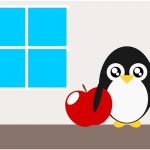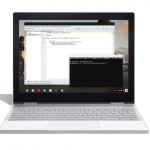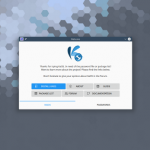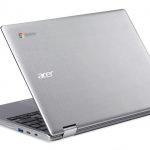Notepad on Microsoft Windows 10 gets Linux and Mac line endings support

Notepad is a classic piece of software. It is the unsung hero of every Windows installation. If you want to jot down a quick note, it is a blank canvas awaiting your keystrokes. As a young man, I used Notepad to write my school papers. Microsoft Office was reserved for rich folks, and there was no LibreOffice -- or even Open Office -- yet. Even the no-frills Microsoft Works was priced out of my family's reach, but I digress.
As Microsoft turns its attention away from the wonderful Paint to focus on the terrible Photos and Paint 3D, you'd expect the company to forget about good ol' Notepad. Surprisingly, however, it hasn't. In fact, the Windows-maker today announces that Notepad on Windows 10 is getting both Linux and Mac line endings support. Wow -- this really is a new Microsoft...
Google's Chrome OS getting support for traditional Linux apps, but don't get excited just yet

Google is a big supporter and user of Linux. Android, for instance, is the most popular Linux-based distribution in the world. Mobile aside, the search giant also leverages the open source kernel for its desktop operating system -- Chrome OS. While some Linux purists decry calling Google's operating systems "Linux," it simply cannot be denied. They are Linux.
I can understand some people suggesting traditional Linux distributions like Ubuntu or Fedora, but Chrome OS -- and the Chromebooks on which it runs -- is arguably more secure while also being easier to use. If I had to choose one operating system for accessing bank websites, for instance, I'd choose Chrome OS over any other. Unfortunately, its limited nature -- which makes it secure and easy to use -- also hinders power users. Sometimes a web or Android app just won't cut it. Well, folks, thankfully the rumors were true -- traditional Linux programs are coming to Chrome OS!
Ubuntu Linux 18.10 is called Cosmic Cuttlefish -- yet another silly name

Ubuntu 18.04 was released last month, and for the most part, it is a solid release. As per usual, version 18.04 was given a silly name -- Bionic Beaver. Canonical follows an alphabetic naming convention, where two words are used that start with that same letter. The first word tends to be an adjective or other descriptive word, while the second word is always an animal. And yes, it is all a bit silly.
With the upcoming Ubuntu 18.10 -- due in October -- the name will be based on the letter "C." Today, Mark Shuttleworth, founder and CEO of Canonical, reveals the next Ubuntu version name -- Cosmic Cuttlefish. Don't know what a cuttlefish is? It's that weird looking thing in the picture above.
KaOS KDE-focused rolling Linux distro celebrates 5th birthday with updated ISO

When a person celebrates a birthday, they often receive gifts, eat cake, and spend time with friends and family. After all, it is intended to be a happy occasion as the person marks another year of life.
But what the heck does a Linux distribution do to celebrate a birthday? In the case of the excellent KaOS operating system, the answer is simple -- release an updated ISO. Yes, as a way to mark the 5th birthday of the KDE-focused distro, version 2018.04 is now available for download. You get Plasma 5.12.4, Linux kernel 4.15.7, Libreoffice 6.0.3, and more.
Cinnamon 3.8 is here, but Linux Mint users can't have it

Linux Mint is a pretty good Linux distribution. Many people love it because of the Cinnamon desktop environment. Hell, despite having other DE versions -- such as Mate -- the Linux Mint operating system sort of exists only because of Cinnamon. I mean, look -- Mint is based on Ubuntu, so if you want to use Mate or Xfce environments, for instance, why not just run Ubuntu Mate or Xubuntu?
The thing is, Cinnamon is available to any distro that wants to use it -- it is not only a Linux Mint affair. Since the Mint team both maintains and popularized Cinnamon, however, it will be forever thought of as a Mint DE -- right or wrong. And that is why today's announcement is so puzzling -- Cinnamon 3.8 is now available (yay!), but no Linux Mint users can try it (boo!).
Fedora 28 is here -- download the overall best Linux-based operating system now!

Yesterday was all about Windows 10. Microsoft released its latest major version, called "April 2018 Update," and it is actually quite good -- for Windows, that is. Linux users won't likely care about that, however, as today there is an arguably more important operating system release -- Fedora 28. Yes, following an official Beta release, the distribution of choice for Linus Torvalds -- the father of Linux -- becomes available today.
Fedora 28 has many new features, but one in particular will surely excite desktop/workstation users -- GNOME 3.28, which introduces Thunderbolt 3 support and improved laptop battery life. Fedora has long used GNOME as the default desktop environment, and best of all, it is mostly a stock affair -- no silly tweaks enabled by default. In other words, you get a very pure GNOME experience, making Fedora Workstation the preferred OS for many hardcore fans of the DE.
Ubuntu Linux 18.04 Bionic Beaver is here -- download it now!

Ubuntu is one of the most popular desktop Linux distributions -- if not the most popular. While it may not be everyone's favorite operating system, it is largely responsible for making Linux accessible for average consumers. It is fairly easy to install, simple to use, and has a convenient application center. Ultimately, it is a pleasure to use for both beginners and experts alike.
Today, following an extensive beta period, the latest version of Ubuntu -- version 18.04 -- becomes available for download. Code-named "Bionic Beaver," it features GNOME 3.28 -- the best desktop environment -- rather than the now-abandoned (and much-maligned) Unity. As per usual, there are other DEs too, such as KDE, Xfce, and MATE. The kernel is based on Linux 4.15 and LibreOffice 6.0 is included by default. Best of all, Bionic Beaver is LTS (Long Term Support), meaning it gets an impressive five years of support.
Discovery of Terminal app for Chrome OS suggests future support for Linux software

Chrome OS is a fairly flexible operating system, and its support for Android apps via the Google Play Store opens up a world of software. It has been thought -- and hoped -- for some time that Linux support might be on its way, and this is looking increasingly likely.
A Terminal app has appeared in the Chrome OS dev channel, strongly suggesting that support for Linux applications could well be on the horizon -- something which will give Chromebooks a new appeal.
Microsoft made its own IoT-ready Linux kernel for Azure Sphere OS

Microsoft has opened up its heart to Linux in recent years, but now the company has done something that would have previously been unthinkable: it has built its own Linux kernel.
As part of its embracing of the Internet of Things, Microsoft has announced Azure Sphere, an ARM-based platform for the IoT with a focus on security. Key to Azure Sphere are small MCU-powered (microcontroller) devices -- essentially SoC devices -- which run Azure Sphere OS and securely connect to Azure backends. Security comes thanks to the use of a custom Linux kernel.
Linus Torvalds says Linux kernel v5.0 'should be meaningless'

Following the release of Linux kernel 4.16, Linus Torvalds has said that the next kernel will be version 5.0. Or maybe it won't, because version numbers are meaningless.
The announcement -- of sorts -- came in Torvalds' message over the weekend about the first release candidate for version 4.17. He warns that it is not "shaping up to be a particularly big release" and questions whether it even matters what version number is slapped on the final release.
Microsoft Windows 10 gains Linux/WSL Console copy and paste functionality

For better or worse, the Windows Subsystem for Linux (WSL) initiative seems to be moving full steam ahead. There are some very respectable distributions available in the Microsoft Store, such as Debian, Ubuntu, and Kali to name a few. Not to mention, Microsoft is trying to encourage even more maintainers to submit their distros with a new tool.
Apparently, some Windows 10 users have been clamoring for the ability to copy and paste both from and to WSL consoles -- a reasonable request. Well, as of Insider Build 17643, this is finally possible.
System76 becomes GNOME Foundation Advisory Board member

System76 has long been a huge champion of both Linux and open source. If you aren't familiar, the company sells premium computers running the Ubuntu operating system. Recently, the company decided to create its own Ubuntu-based distro called "Pop!_OS" which uses the GNOME desktop environment.
Today, Denver, Colorado-based System76 takes its commitment to GNOME even further by becoming a Foundation Advisory Board member. It joins other respected companies on the board such as Google, Red Hat, and Canonical to name a few.
Ubuntu Linux 18.04 LTS 'Bionic Beaver' Beta 2 now available

Ubuntu Linux 18.04 "Bionic Beaver" is almost here -- it is due on April 26. In the interim, today, the second -- and final -- beta becomes available. Bionic Beaver is very significant, as it is an LTS version, meaning "Long Term Support." This is important to those that prefer stability to bleeding edge and don't want to deal with the hassle of upgrades. In other words, you can install 18.04 and be confident that it will be supported for 5 years. In comparison, non-LTS Ubuntu versions get a mere 9 months.
There is plenty to be excited about with Ubuntu Linux 18.04 LTS 'Bionic Beaver' Beta 2, including the GNOME 3.28 desktop environment -- Beta 1 did not include GNOME at all. Of course, all the other DE flavors are available too, such as KDE and Xfce. The kernel is at 4.15, which while not the most current version, is still quite modern. Also included is LibreOffice 6.0 -- an essential tool that rivals Microsoft Office. Wayland is available as a technical preview, although X remains the default display server -- for now.
Fedora 28 Beta Linux distro is finally here

Fedora is the best overall Linux-based desktop operating system -- Linus Torvalds famously uses it regularly. Today, version 28 of the distribution finally achieves Beta status. After a short delay -- it was scheduled to be available a week earlier -- the distro is back on track, and looking better than ever.
As is typical now, there are three versions of the operating system -- Atomic Host, Server, and Workstation. While all three have their places, normal desktop computer users will want to focus on Workstation. There are plenty of new features (and bugs), but the most exciting aspect of Fedora 28 Workstation is the inclusion of the GNOME 3.28 desktop environment.
Linux 4.16 launches

Just over a week ago, Linus Torvalds said that the release of Linux 4.16 could take place on Sunday April 1. Ignoring the fact that April Fool's day is a terrible day to do just about anything, he made good on his promise.
As predicted, there was no RC8 of the kernel, and Torvalds notes that the final release is very similar to RC7. In a post to the Linux Kernel Mailing List, he also said that the merge window for 4.17 is open, but for now, the focus is on 4.16.
Recent Headlines
Most Commented Stories
BetaNews, your source for breaking tech news, reviews, and in-depth reporting since 1998.
© 1998-2025 BetaNews, Inc. All Rights Reserved. About Us - Privacy Policy - Cookie Policy - Sitemap.